生产函数决定成本函数
- 格式:ppt
- 大小:3.87 MB
- 文档页数:10

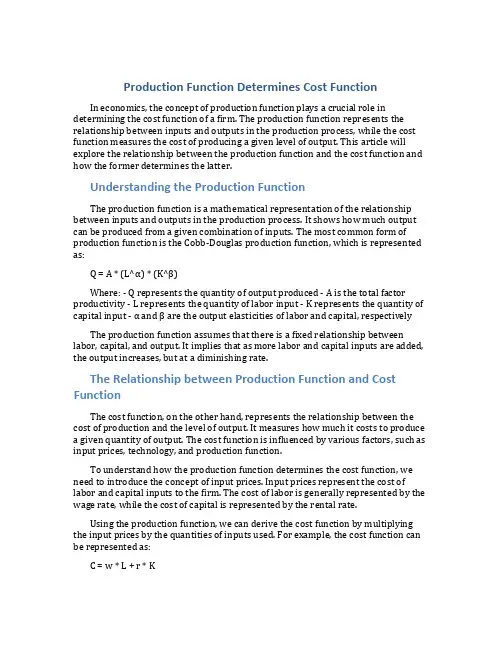
Production Function Determines Cost Function In economics, the concept of production function plays a crucial role in determining the cost function of a firm. The production function represents the relationship between inputs and outputs in the production process, while the cost function measures the cost of producing a given level of output. This article will explore the relationship between the production function and the cost function and how the former determines the latter.Understanding the Production FunctionThe production function is a mathematical representation of the relationship between inputs and outputs in the production process. It shows how much output can be produced from a given combination of inputs. The most common form of production function is the Cobb-Douglas production function, which is represented as:Q = A * (L^α) * (K^β)Where: - Q represents the quantity of output produced - A is the total factor productivity - L represents the quantity of labor input - K represents the quantity of capital input - α and β are the output ela sticities of labor and capital, respectively The production function assumes that there is a fixed relationship between labor, capital, and output. It implies that as more labor and capital inputs are added, the output increases, but at a diminishing rate.The Relationship between Production Function and Cost FunctionThe cost function, on the other hand, represents the relationship between the cost of production and the level of output. It measures how much it costs to produce a given quantity of output. The cost function is influenced by various factors, such as input prices, technology, and production function.To understand how the production function determines the cost function, we need to introduce the concept of input prices. Input prices represent the cost of labor and capital inputs to the firm. The cost of labor is generally represented by the wage rate, while the cost of capital is represented by the rental rate.Using the production function, we can derive the cost function by multiplying the input prices by the quantities of inputs used. For example, the cost function can be represented as:C = w * L + r * KWhere: - C represents the total cost of production - w represents the wage rate - r represents the rental rate - L represents the quantity of labor input - K represents the quantity of capital inputThe cost function shows the minimum cost of producing a given level of output. It reflects the cost of labor and capital inputs required to produce that level of output, based on the given input prices.Impact of Changes in Production Function on Cost Function Changes in the production function can have a significant impact on the cost function. If the production function changes, it alters the relationship between inputs and outputs, which in turn affects the cost of production.For example, if there is an improvement in technology, it increases the total factor productivity (A) in the production function. As a result, more output can be produced for a given combination of inputs, reducing the cost of production. This, in turn, shifts the cost function downwards, reflecting lower costs for the same level of output.Similarly, changes in the output elasticities (α and β) can also impact the cost function. If there is an increase in the output elastici ty of labor (α), it implies that labor becomes more productive and can produce more output with the same quantity of inputs. This leads to a decrease in the cost of labor and, subsequently, a downward shift in the cost function for the same level of output.On the other hand, an increase in the output elasticity of capital (β) would lower the cost of capital and cause a downward shift in the cost function.ConclusionIn conclusion, the production function serves as the basis for determining the cost function in economics. It shows the relationship between inputs and outputs in the production process. The cost function, on the other hand, measures the cost of producing a given level of output. By understanding the production function and its impact on the cost function, firms can make informed decisions about their production processes and cost management strategies.。

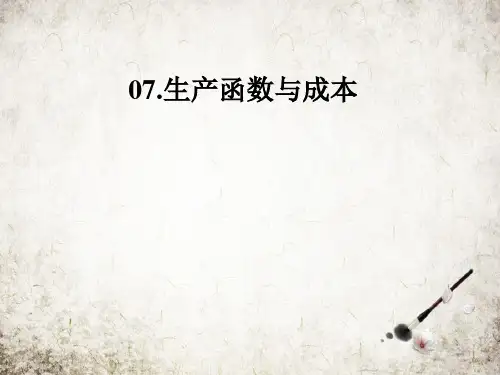

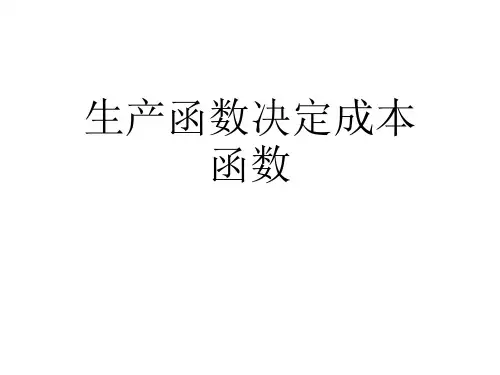

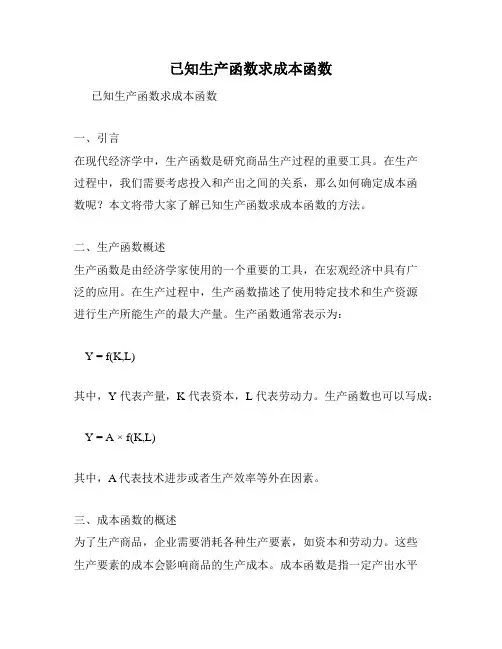
已知生产函数求成本函数已知生产函数求成本函数一、引言在现代经济学中,生产函数是研究商品生产过程的重要工具。
在生产过程中,我们需要考虑投入和产出之间的关系,那么如何确定成本函数呢?本文将带大家了解已知生产函数求成本函数的方法。
二、生产函数概述生产函数是由经济学家使用的一个重要的工具,在宏观经济中具有广泛的应用。
在生产过程中,生产函数描述了使用特定技术和生产资源进行生产所能生产的最大产量。
生产函数通常表示为:Y = f(K,L)其中,Y代表产量,K代表资本,L代表劳动力。
生产函数也可以写成: Y = A × f(K,L)其中,A代表技术进步或者生产效率等外在因素。
三、成本函数的概述为了生产商品,企业需要消耗各种生产要素,如资本和劳动力。
这些生产要素的成本会影响商品的生产成本。
成本函数是指一定产出水平下,生产所需要的最小成本。
成本函数通常表示为:C = wL + rK其中,w代表单位劳动力的成本,r代表资本的机会成本。
L和K分别代表使用的劳动力和资本的数量。
四、已知生产函数求成本函数的方法已知生产函数,我们可以通过下面的步骤来求解成本函数:1. 对生产函数进行对数化转换,得到:ln Y = ln A + α ln K + (1-α) ln L其中,α代表产出弹性。
我们假设生产函数来自某家企业,且该企业所有的输入要素的成本是已知的,即wL + rK = C2. 对式子进行求导:d(ln Y)/d(ln K) = αd(ln Y)/d(ln L) = 1-α3. 代入成本函数,得到:ln Y = ln A + d(ln Y)/d(ln K) ln K + d(ln Y)/d(ln L) ln Lln Y - ln A = α ln K + (1-α) Lln(Y/A) = α ln K + (1-α) ln Lln(Y/A)-ln L^(1-α) = α ln K4. 求解K:K = (Y/A)/(L^(1-α) × exp(α ln K))5. 将K代入成本函数中,得到:C = wL + r(Y/A)/(L^(1-α) × exp(α ln K))至此,我们就求得了成本函数的表达式。
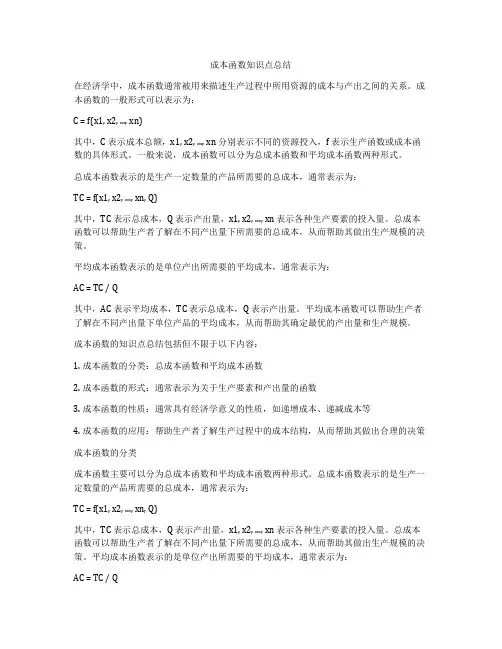
成本函数知识点总结在经济学中,成本函数通常被用来描述生产过程中所用资源的成本与产出之间的关系。
成本函数的一般形式可以表示为:C = f(x1, x2, ..., xn)其中,C 表示成本总额,x1, x2, ..., xn 分别表示不同的资源投入,f 表示生产函数或成本函数的具体形式。
一般来说,成本函数可以分为总成本函数和平均成本函数两种形式。
总成本函数表示的是生产一定数量的产品所需要的总成本,通常表示为:TC = f(x1, x2, ..., xn, Q)其中,TC 表示总成本,Q 表示产出量,x1, x2, ..., xn 表示各种生产要素的投入量。
总成本函数可以帮助生产者了解在不同产出量下所需要的总成本,从而帮助其做出生产规模的决策。
平均成本函数表示的是单位产出所需要的平均成本,通常表示为:AC = TC / Q其中,AC 表示平均成本,TC 表示总成本,Q 表示产出量。
平均成本函数可以帮助生产者了解在不同产出量下单位产品的平均成本,从而帮助其确定最优的产出量和生产规模。
成本函数的知识点总结包括但不限于以下内容:1. 成本函数的分类:总成本函数和平均成本函数2. 成本函数的形式:通常表示为关于生产要素和产出量的函数3. 成本函数的性质:通常具有经济学意义的性质,如递增成本、递减成本等4. 成本函数的应用:帮助生产者了解生产过程中的成本结构,从而帮助其做出合理的决策成本函数的分类成本函数主要可以分为总成本函数和平均成本函数两种形式。
总成本函数表示的是生产一定数量的产品所需要的总成本,通常表示为:TC = f(x1, x2, ..., xn, Q)其中,TC 表示总成本,Q 表示产出量,x1, x2, ..., xn 表示各种生产要素的投入量。
总成本函数可以帮助生产者了解在不同产出量下所需要的总成本,从而帮助其做出生产规模的决策。
平均成本函数表示的是单位产出所需要的平均成本,通常表示为:AC = TC / Q其中,AC 表示平均成本,TC 表示总成本,Q 表示产出量。

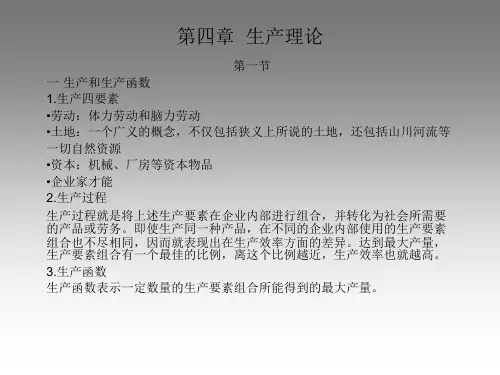
生产函数与成本函数的关系在经济学中,生产函数和成本函数是两个重要的概念,它们描述了生产过程中的关系和资源利用的效率。
生产函数描述了生产过程中输入与输出的关系,而成本函数则衡量了实现这些输入输出关系所需要的资源费用。
本文将探讨生产函数与成本函数之间的关系,以及它们在经济中的应用。
首先,我们来深入理解生产函数。
生产函数是描述输入和输出之间关系的数学表达式。
它可以用来衡量生产过程中投入要素(如劳动力、资本、原材料等)与产出之间的数量关系。
一般来说,生产函数可以用以下的形式表示:Y = f(K, L)其中,Y代表产出,K代表资本,L代表劳动力。
这种表示方式是最为简单的形式,也称为柯布-道格拉斯生产函数。
其实,生产函数的形式有很多种,可以是线性的、非线性的、具有不同的弹性等。
不同的生产函数反映了不同的生产技术水平和资源利用效率。
然而,生产函数仅仅描述了输入和输出之间的数量关系,并没有考虑到资源的使用成本。
这时候,就需要引入成本函数的概念。
成本函数描述了实现某种生产函数关系所需要的资源费用。
成本函数的形式也有多种,最简单的形式可以表示为:C = wL + rK其中,C代表成本,w代表单位劳动力的价格,L代表劳动力的数量,r代表单位资本的价格,K代表资本的数量。
这种形式的成本函数是线性的,假设劳动力和资本的价格保持不变。
由生产函数和成本函数的定义可知,生产函数和成本函数之间有密切的关系。
实际上,我们可以通过生产函数推导出成本函数,或者根据成本函数推导出生产函数。
利用这种关系,我们可以进行企业生产效率的分析、资源配置和成本优化等经济决策。
例如,假设我们需要分析一家企业的生产效率。
通过观察生产过程中输入与输出的关系,我们可以估算出该企业的生产函数。
再通过观察企业的成本支出情况,可以计算出相应的成本函数。
通过比较生产函数和成本函数,我们就可以评估该企业的资源利用效率。
如果生产函数的斜率(即边际产出)大于成本函数的斜率(即边际成本),那么说明该企业的资源利用相对高效;反之,如果边际产出小于边际成本,说明该企业的资源利用相对低效。